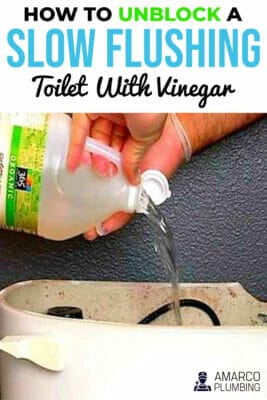Disclaimer: This post may contain affiliate links, meaning we get a small commission if you make a purchase through our links, at no cost to you. For more information, please visit our Disclaimer Page.
Let’s be honest, this chore is not something that thrills you, but still, it has to be done. Once you start looking for solutions, you will find numerous answers.
A sigh of relief here! Most of them do the job, and sometimes quick and simple fixes just do work.
What to do when the toilet won’t flush as fast as it should?
Is there anything you can do quickly to solve it?
What about home remedies that could help?
Do you need to call a plumber immediately or there’s something that you can do to solve the issue? Let’s find out!
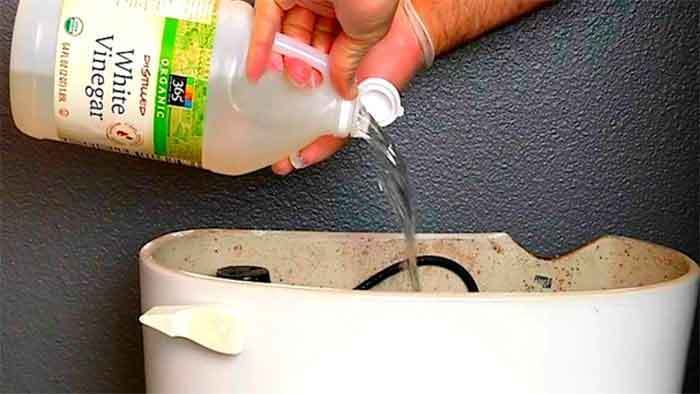
6 reasons for slow flushing toilet
Before you just pour vinegar into the toilet, you must be aware that the flushing becomes slower for various reasons.
For some of them, this method works just fine, but sometimes it’s beyond that. The key is in finding the very source of the problem.
Here’s the list of the most common causes:
1. Pipes are leaking
The main characteristic of this problem is low water pressure. If not fixed on time, this can contaminate the water, so you need to act fast, and have them replaced.
2. Damaged toilet bowl
Let’s describe this as a typical “wear and tear” consequence. Needless to mention that this is a frequently used place in the house, and therefore various damages occur due to that.
The easiest and most logical way to solve the problem is to replace the bowl.
3. Clogs
They can be either partial or total, and the approach depends on that. Moreover, the obstacles can be of physical origin (something like a small object) or organic (like soap residues, hair, grease and similar).
Clogged toilet often leads to a dreaded overflow, so the best is to react on time.
4. The water level is too low
There’s a certain recommended level, and when there’s insufficient amount of water, the flushing power is decreased.
Intense force is the key to empty the bowl. Therefore, you need to find what caused this and repair it.
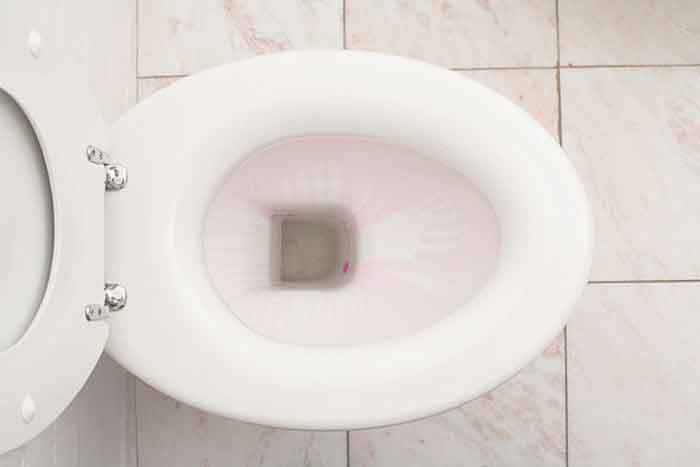
5. Mineral build-ups along the rim
Minerals accumulate with each flush, and step by step, flushing gets slower.
In order to avoid additional issues, you should clean these deposits using a metallic tool and a mineral remover.
6. The flapper valve is faulty
After the tank empties, this part is normally set to return in a pre-defined condition. If water level is too low, as the time goes by it doesn’t seal properly and it slows the flushing down.
If worn out, consider replacing it, similar to the advice we gave you on the bowl.
As you can see, these are quite logical and common, in a way, expected problems. Luckily each of them has a solution.
The most important is to react on time and don’t let any of these escalate into additional troubles.
How to Unblock a Slow Flushing Toilet with Vinegar
Now that you know what causes a decrease in power, the answer to this is quite simple. Maintaining hygiene on regular basis is the starting point. This particularly goes for clogs and mineral build-ups.
However, when a problem is in some part of the construction, so to say, then the approach is different.
Sometimes it is within the limits of your own powers to fix it, but if it’s too complicated, do not hesitate to call a professional.
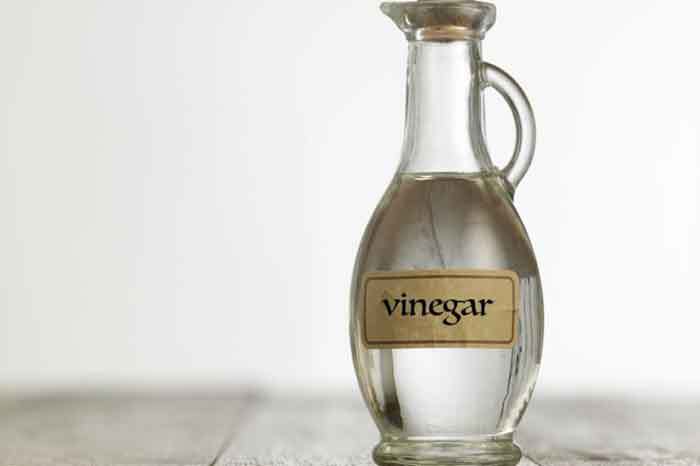
Cleaning Jets with Vinegar and Soda
But, for some simple situations such as clogs and rims filled with mineral deposits, you can react on time without the need to hire a plumber.
Like we already mentioned, it takes proper tools and liquids, either for unclogging or removing mineral deposits, and the issue will be solved.
Cleaning the dirty jets that inhibit the water delivery to your toilet bowl can be done very easily, just with a help of vinegar and baking soda.
- Empty the bowl and place a sponge in the toilet – What you will have to do to pull out this technique correctly is to simply empty the water from the toilet bowl.
Now, find a large sponge, put it in a plastic bag, and place it inside of your emptied toilet bowl. - Add vinegar and baking soda – Now, pour some baking soda (about one cup) and vinegar (approximately the same amount) over the sponge and just to the rim of the toilet bowl.
Remember to pour the vinegar over the baking soda very slowly. If you pour it too quickly, it can make a mess out of your toilet.
Furthermore, if the mixture is not fizzing enough, pour more baking soda. Same stands if the mixture you made is not touching the rim of the toilet bowl.
Give it a few hours for the jets to soak in the mixture of baking soda and vinegar. If you can let it sit like that overnight – even better! - Vinegar into the overflow tube – While you still have the jets soaking in the mixture you made, use a funnel and pour vinegar into the overflow tube from the inside. This too need some time to start working, so let it sit there for a few hours as well.
- Remove the “plug” – Once you figure that it was enough of soaking for the jets (again, we would suggest you to take some time and even let it sit like that for a whole night) remove the sponge plug you made, and flush the toilet a few time.
Vinegar and baking soda are supposed to make the calcium and other materials that have built up on the jets over time soft, so that these can be rinsed more easily.
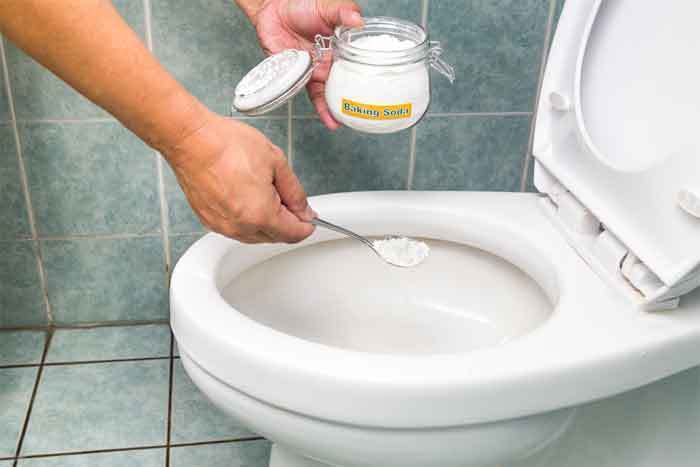
If this method didn’t help the first time, you are free to try again. But if it fails to make any major differences the second time you try it, it just might not be in your power to fix it and you should better call for professional help.
Vinegar As Antibacterial Liquid
Vinegar is excellent for disinfection of the surfaces in your household. Therefore, as the toilet is the place where can most bacteria thrive, it is the easiest way to kill the germs.
For this matter, I am suggesting less diluted vinegar, with at least 6% of acid. The higher acidity, the fewer germs will survive.
Also, with high acidity goes higher vulnerability of your skin. Therefore, it is necessary to use hygienic gloves to protect your skin.
Keep away from getting in touch vinegar with your eyes, or any part of your face.
What type of vinegar is good for cleaning?
If you ever went shopping for vinegar at a supermarket, you had seen probably so many types of vinegar that are even hard to choose for cooking.
You can find white vinegar, apple cider vinegar, wine vinegar, balsamic vinegar, rice vinegar, malt vinegar, raisin vinegar, etc.
Yet, the vinegar is useful for cleaning not because of a special sort, but because of its acidity. So, whichever type you have in your household, you can use it for cleaning.

Since the white vinegar is the most common and usually the cheapest one, my instruction comes with this one.
I did use this one and examined the effect with it, but if you use another, the effect will be the same.
Special kind of vinegar – cleaning ones
Due to the wide usage of vinegar, a special kind of vinegar has appeared in the market: those that have been specially made for cleaning.
Therefore, you can now buy vinegar with the scents of lemon, lavender, mandarin or eucalyptus, which covers the acidic smell of the usual vinegar.
Actually, this is the best combination that covers both ecological and practical aspects.
If you do not like to use manufactory cleaning products because of its non-organic aspects, now you can be conscious toward your environment and avoid that acidic smell of the vinegar.
To be honest, if you clean the whole bathroom with vinegar, as I did once, it will last for a few days until the bad smell disappears.
One of the best known product in the market is Aunt Fannie's vinegar. It contains scents of lavender, eucalyptus, fresh lime mint, and sweet mandarin. Aunt Fannie's vinegar is safe for use around kids and pets.
It is made from essential oils and ingredients from the food industry. This product has been awarded the highest safety rate in the class of cleaning products by the Environmental Working Group.
Another popular product is White House Food's Cleaning Vinegar. It comes in lavender, lemon, and the original scent. This product has 6% acidity, and it is 100% natural.
The majority of the customers have agreed that this product is great for limiting exposure to harmful chemicals, and it has many different uses.
The toilet is just one of them. Yet for this article, I am researching the influence and the using of the vinegar for cleaning the toilet. It is great for cleaning the lime and the stains of water in your toilet.
Also, it removes greasiness out of your pipes. It is especially useful if anyone spills food remains into the toilet.
When to call a plumber?
Now that you know that most of the situations can be easily dealt by applying some of the simple DIY fixes, it may come to your mind “Do I need a plumber, after all?”
The answer to the question is positive (plumbers are jumping with joy!) as some problems may go way beyond some common skills of an average person.
As a matter of fact, trying to solve the problem that is obviously the one requiring a professional’s help on your own can cause more troubles, if done improperly.
One of such situations is a problem with pipes and drains. If this is what caused the slower running toilet, then do not hesitate to call a pro, as this definitely requires adequate tools and fond knowledge in this field. Click the banner below for a free quote.
Final Thoughts: Slow Flushing Toilet with Vinegar
As you can see, this kind of problem is not something that should make you feel desperate, as it’s quite a common one.
So many people deal with it on daily basis, and it’s only natural that there are so many suggestions on how to avoid it. Even if it happens, there are numerous tips on how to fix it.
Maintaining the cleanliness at some desired level is an essential starting point for avoiding troubles. There are numerous effective products available, as well as some interesting DIY recipes for this.
For example, cleaning slow flushing toilet with vinegar or baking soda. You can even find some useful tools in case an object represents the obstacle.
However, if you are not sure that you are able to deal with the situation yourself, that’s what plumbers are for. After all, the main point is to remove the problem and have it work properly again.
So, whatever you choose to be the most suitable solution, make sure you apply it as soon as possible.
